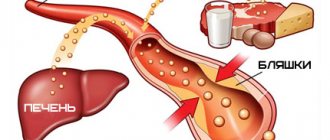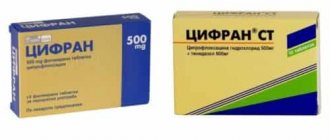Instructions for use FUROSEMIDUM
The use of furosemide requires regular medical and laboratory monitoring.
During treatment with the drug, it is necessary to ensure a constant flow of urine.
During treatment, regular monitoring of serum sodium, potassium, calcium, chloride, magnesium and creatinine levels is recommended, especially in patients at high risk of developing electrolyte imbalance or in cases of significant fluid loss (vomiting, diarrhea, intense sweating).
Hypovolemia, dehydration, and any significant disturbances in electrolyte and acid-base balance must be corrected, which may require temporary cessation of furosemide.
When using the drug, patients should be advised to eat foods high in potassium. It should be remembered that when using furosemide, it may be necessary to compensate for potassium loss with medication. Particular care should be taken when prescribing the drug and monitoring the condition:
- patients in whom the latent form of diabetes can become pronounced or patients with diabetes with an increased need for insulin;
- patients with gout. The use of furosemide slows down the excretion of uric acid and can provoke an attack of gout;
- patients with hepatorenal syndrome;
- patients with hypoproteinemia caused by nephrotic syndrome or liver cirrhosis (weaker effect of furosemide, but there is a risk of ototoxicity);
- patients with urinary disorders (prostatic hypertrophy or urinary tract obstruction), who may develop acute urinary retention (while taking the drug, a constant outflow of urine must be ensured);
- patients with arterial hypotension;
- patients who are at particular risk due to a significant decrease in blood pressure, for example, patients with severe stenosis of the coronary arteries or blood vessels supplying blood to the brain.
There have been cases of photosensitivity reactions with the use of thiazide diuretics. If such reactions occur during treatment, it is recommended to stop treatment. If it is necessary to resume use of the drug, measures to protect skin areas exposed to sunlight or artificial UV are recommended.
Athletes
Taking furosemide may result in a false positive test result during doping control.
This medicinal product contains lactose as an excipient and may therefore pose a risk for patients with rare hereditary forms of galactose intolerance, lactase deficiency or glucose-galactose malabsorption.
Children
The drug is not used for children weighing less than 10 kg. The dose for children should be reduced according to body weight.
The ability to influence the reaction rate when driving a vehicle or working with other mechanisms
During treatment with the drug, the ability to concentrate may decrease. Persons driving vehicles and working with dangerous machinery should refrain from using the drug.
Furosemide-dependent kidney
The diagnosis is made by a nephrologist; it is not difficult for patients who have been taking furosemide for a long time and have characteristic clinical manifestations caused by impaired renal excretory function. Difficulties may arise in the early stages of the disease, when symptoms are represented by nonspecific changes of a general nature. To diagnose furosemide-dependent kidney, methods such as:
- Blood chemistry.
Shifts in the electrolyte composition of the plasma are observed - a decrease in the concentration of sodium, potassium, chlorides, calcium, and magnesium. At a later stage, there may be an increase in urea and creatinine levels, correlating with the severity of morphological changes. The furosemide-dependent form of renal dysfunction is also characterized by hypoproteinemia. - General urine analysis
. With organic kidney damage, hypoisosthenuria, moderate proteinuria, cylindruria, erythrocyturia, and leukocyturia can be detected in the urine. The study is complemented by a biochemical analysis that reveals increased levels of potassium, sodium, chlorine, calcium, and magnesium. To assess the excretory and concentration function of the kidneys, a Zimnitsky test is performed. - Ultrasound of the kidneys
. Sonography allows you to assess the size and shape of the organ, the structure of the cortex and medulla, and measure the thickness of the renal parenchyma. Detection of changes in the anatomical structure during ultrasound examination is an unfavorable prognostic sign. The method is not very informative at the early stage of the disease, when there are no macroscopic abnormalities.
Changes in the clinical blood test (decrease in the number of red blood cells and hemoglobin) are detected only in severe cases of furosemide-dependent kidney damage. To determine the functional capacity of an organ, the glomerular filtration rate is assessed using the Rehberg test. For a comprehensive study of the state of the urinary system, excretory urography, CT, MRI of the kidneys, and nephroscintigraphy can be performed.
Differential diagnosis of lasix-dependent renal disorder is carried out with Barter syndrome, family hypomagnesymia with hypercalcium and nephrocalcinosis, hypochloremic azotemia, hepatiental syndrome, acute and rapidly processing glomerulonefritis, pyelonephritis, and nephropathy for eomaimumenous diseases. beggar tissue, kidney tumors, primary and secondary hyperaldosteronism. It is important to exclude extrarenal losses of fluid and electrolytes due to diarrhea, cystic fibrosis, and laxative abuse.
Furosemide overdose: chronic
Overdose of medications is possible in chronic form. Develops as a result of constant use of increased dosages of furosemide. Systematic use of the medicine leads to the appearance of unpleasant symptoms.
We recommend: Consequences of afobazole overdose ✅ - symptoms and treatment
What happens:
- The occurrence of thrombophlebitis,
- intestinal disorder,
- Vomiting, nausea,
- The appearance of inflammatory processes in the pancreas,
- Stagnation of bile,
- Hearing impairment
- Confusion of thoughts and consciousness,
- Sudden weight loss, anorexia,
- Constant dizziness, intense pain,
- The presence of allergic manifestations on the skin.
Furosemide has the potential to cause addiction. After some time, the kidneys stop responding to the prescribed dosage. To obtain an effect, it is necessary to increase the amount of the drug taken, which can lead to the development of signs of overdose.
The exact dosage at which death is possible has not been established. However, this drug is used with extreme caution and as prescribed by a physician.
How can you get an overdose?
Furosemide therapy is carried out in adults and in children over three years of age. For treatment at home, a strictly defined dosage is selected individually for each patient. Why is it possible to develop a drug overdose? There are several reasons that can lead to poisoning.
We recommend: Selenium overdose in the body - symptoms in women and men
Causes:
- Incorrect medication prescription and incorrect dosage regimen,
- Self-treatment with medication
- Unintentional use of higher dosages in the elderly and children,
- Using furosemide as a weight loss medication,
- Intolerance to any component, and, as a result, the development of serious allergic reactions and overdose.
Poisoning in children often occurs as a result of the carelessness of parents who leave the medicine in an accessible place.
How many tablets is a patient allowed to take? The initial dosage of the drug does not exceed 80 mg per day . Gradually the amount of medication is increased. The maximum allowable value is 1500 mg, divided into several doses.
In rare exceptions, a maximum of 600 mg can be consumed at one time. Exceeding the prescribed amount of furosemide can lead to acute overdose. This condition has its own ICD code – 10 – T50.1.
When is medical help needed?
Medical attention is required in all cases of furosemide intoxication. However, in some cases you need to see a doctor very quickly.
Occasions:
- The child was injured
- Very low pressure
- Lack of consciousness, disturbance of orientation in space,
- Sudden irregularities in heart rhythm,
- Respiratory disorder
- Presence of symptoms of dehydration,
- Sharp blue discoloration of the skin,
- Presence of blood in vomit and feces.
We recommend: Vitamin E poisoning
In a medical institution, the patient is given a set of actions to help reduce the toxic effects on the body.
Actions:
- Administration of medicinal solutions that increase the volume of circulating blood,
- Using a ventilator,
- Prescribing medications to normalize the functionality of the cardiac and respiratory systems,
- Various procedures aimed at eliminating all violations.
Overdose is treated until complete recovery. If necessary, special vitamin complexes are selected. There is no specific antidote for overdose.
Signs of acute drug overdose
An acute overdose manifests itself quite quickly. First of all, a person’s blood pressure drops sharply. Gradually, unpleasant symptoms develop.
Symptoms:
- Weakness, lethargy, apathy,
- Painful sensations in the back of the head,
- Respiratory dysfunction, shortness of breath,
- Increased sweating
- Dizziness,
- Nausea, urge to vomit,
- Noise in ears,
- Decreased body temperature
- Development of convulsive manifestations.
With excessive intake of furosemide and acute overdose, a decrease in the amount of circulating blood occurs, which leads to disruption of the blood supply to internal organs. The consequences of this phenomenon can be disturbances in the functioning of the kidneys, heart, and death.
When furosemide is consumed in large quantities, the body becomes dehydrated. The result is disruption of many systems. Blood thickening is often observed when taking furosemide in an increased dosage. Such an overdose causes disruptions in the functioning of the cardiac system and the development of heart attacks.
First aid for overdose
What to do if an overdose occurs? If signs of poisoning appear, it is recommended to call a medical team. Before their arrival, I provide first aid to the victim at home.
Actions:
- In case of an overdose of tablets, the victim is given a gastric lavage with clean water.
- The patient is given any available sorbent to drink,
- In case of an overdose, a person needs to drink a lot of liquid in small sips to avoid dehydration.
- To restore blood pressure, it is recommended to drink warm tea.
In case of a severe overdose, the victim needs to be kept at rest, covered with a blanket and wait for the medical team to arrive.
What could be the consequences?
An overdose of medication adversely affects the functionality of organs and systems. The consequences of such poisoning are quite serious.
What happens:
- Development of acute renal failure,
- Thromboembolism,
- Shock conditions,
- Collapse,
- The occurrence of a coma,
- Death.
Furosemide poisoning can cause serious harm to the body. Dehydration contributes to the development of irreversible consequences in the functioning of systems and organs. If unpleasant signs appear while taking furosemide, it is recommended to stop treatment and consult a doctor.







